七年级英语:Finding your way教案(实用文本)
- 格式:docx
- 大小:48.29 KB
- 文档页数:9
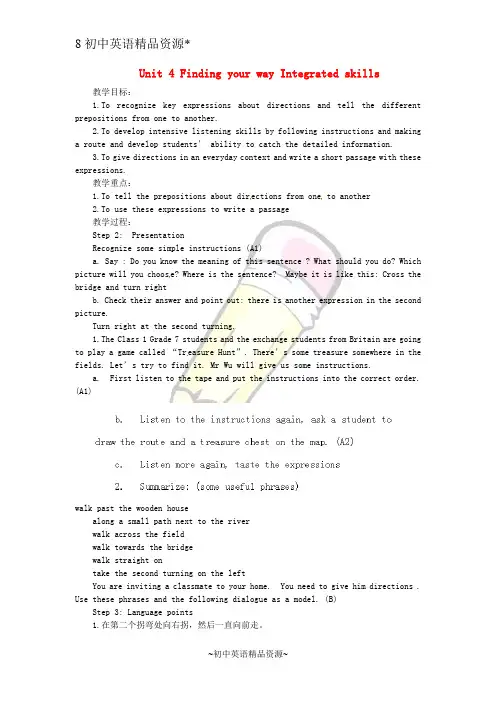
Unit 4 Finding your way Integrated skills教学目标:1.To recognize key expressions about directions and tell the different prepositions from one to another.2.To develop intensive listening skills by following instructions and makinga route and develop stud ents’ ability to catch the detailed information.3.To give directions in an everyday context and write a short passage with these expressions.教学重点:1.To tell the prepositions about dir ections from one to another2.To use these expressions to write a passage教学过程:Step 2: PresentationRecognize some simple instructions (A1)a. Say : Do you know the meaning of this sentence ? What should you do? Which picture will you choos e? Where is the sentence? Maybe it is like this: Cross the bridge and turn rightb. Check their answer and point out: there is another expression in the second picture.Turn right at the second turning.1.The Class 1 Grade 7 students and the exchange students from Britain are going to play a game called “Tr easure Hunt”. There’s some treasure somewhere in the fields. Let’s try to find it. Mr Wu will give us some instructions.a. First listen to the tape and put the instructions into the correct order. (A1)walk past the wooden housealong a small path next to the riverwalk across the fieldwalk towards the bridgewalk straight ontake the second turning on the leftYou are inviting a classmate to your home. You need to give him directions . Use these phrases and the following dialogue as a model. (B)Step 3: Language points1.在第二个拐弯处向右拐,然后一直向前走。
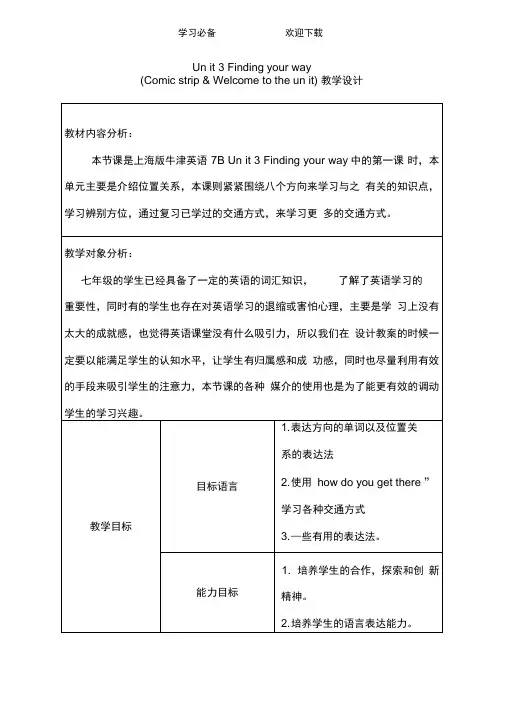
Un it 3 Finding your way (Comic strip & Welcome to the un it) 教学设计学习必备欢迎下载The outl ine chart任务循环流程(Task-cycle):利用家乡的地图让学生操练以上的两个知识点。
完成书本上的一个习题。
播放Hobo和Eddie的一段录像带,并根据录像内容回答几个问题。
学生合作表演Hobo和Eddie的对话。
呈现有用的句型通过做填空练习复述对话,巩固句型。
Teachi ng procedures教学环节教师活动学生活动设计意图与媒体使用前任务(Pre-Task) 教师引入任务2.呈现另一张图片进一步教授学生东南,西南,东北,西北的说法。
3 ;再次利用中国地图让学生巩固新知,说出哪些城市在安徽的North-eastSouth-eastNorth-westsouth-west4•问学生如果想去这些城市,可以乘坐那些交通工具,同时, 教授新的交通方式.(此步骤复习旧知,引出新知通过教师的提问How do you goto Beijing ? ”帮助学生回答出I can go there byair /plane.由由此引出各种交通方式的表达法,并教学生区分take aplane 禾口by plane的用法区别。
MOirtthNorth-westUSilAlly 舞u aii A trip? bybike, by canon foot.I by train.by planefair1.呈现一张家乡的地图问学生,“Spri ngbyby bu臥byunderground.任务循环流程(Task-cycle) is coming ,let s 'go on aspri ng outi ng ,whichplace in the map do youwant to go ? How can youget there ?师生对话对所呈现的知识点进行操练1.学生通过地图利用前任务中的两个学习目标表达自己的意愿,教师给予帮助,并适时的做出点评在任务型的教学设计中,这部分占得比例比较大,主要是通过各种形式的练习或操练来让学生熟悉新知识的用法,达到学以致用的目的,通过视频的播放让有些枯燥的学习过程多了分乐趣,有利于学生集中注意力。
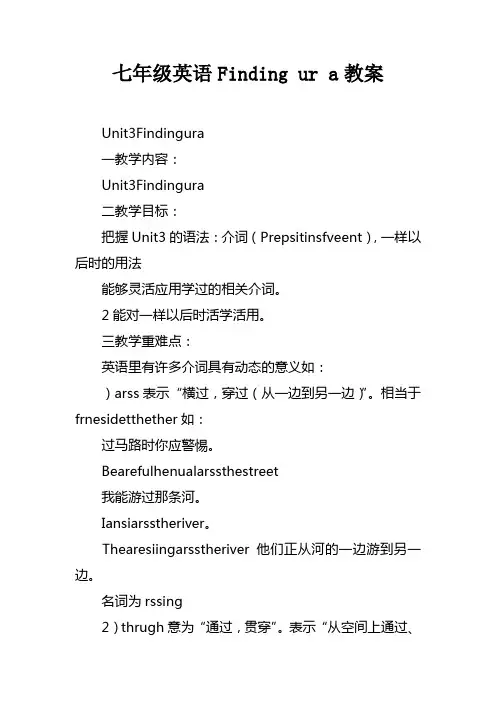
七年级英语Finding ur a教案Unit3Findingura一教学内容:Unit3Findingura二教学目标:把握Unit3的语法:介词(Prepsitinsfveent),一样以后时的用法能够灵活应用学过的相关介词。
2能对一样以后时活学活用。
三教学重难点:英语里有许多介词具有动态的意义如:)arss表示“横过,穿过(从一边到另一边)”。
相当于frnesidetthether如:过马路时你应警惕。
Bearefulhenualarssthestreet我能游过那条河。
Iansiarsstheriver。
Thearesiingarsstheriver他们正从河的一边游到另一边。
名词为rssing2)thrugh意为“通过,贯穿”。
表示“从空间上通过、穿过”汽车穿过隧道。
Theargesthrughthetunnel阳光透过窗户。
Thesunshinegetsthrughtheind。
Aarisgingthrughatunnel轿车正从隧道穿过。
3)ver表示“越过”“从……上边过去”Helibedverthehill他爬过了小山。
4)t表示“向”“往”“到”。
Iaalingtthedr我在朝门口走去。
)fr表示“自”“从”“来自……(起点,)”Thearealingfrthesfattheind6)alng意为“沿着”Iftenalalngtheradturshl 我常常沿着这条路去咱们学校。
7)rund表示“围绕,绕”。
Theearthgesrundthesun地球围绕太阳转。
8)up表示“向上”能够作介词和副词,意为“往上”,“向……上”他正爬上山。
Heislibingupauntain他正从楼梯往上走。
Heisalingupthestairsdn表示"向下"Thelifttaesusupanddn电梯带咱们上下。
用适当的介词填空Thetrainisging_________thetunnelTheatislibing_____thetreeTliesuping______thehairThestudentsarerunning______theplagrundinthePElass ieals____shleverdaIfthetraffilightisreduan’tal________theradusinftentaeshispetfraal_______thestreetPleaseput_______thevase,ruabreaitIt’s2hurs______hetthepar选词填空arss,alng,ver,t,up,dn,thrugh,rund,utf,frHeis_______RussiaG______thisradandu’llfindthehtelAtigerisrunning______thefresttherfteng_______thesuperaretAatislibing____thetree,beausethereisabirdinitSit____,please2一样以后时是本单元的语法重点。
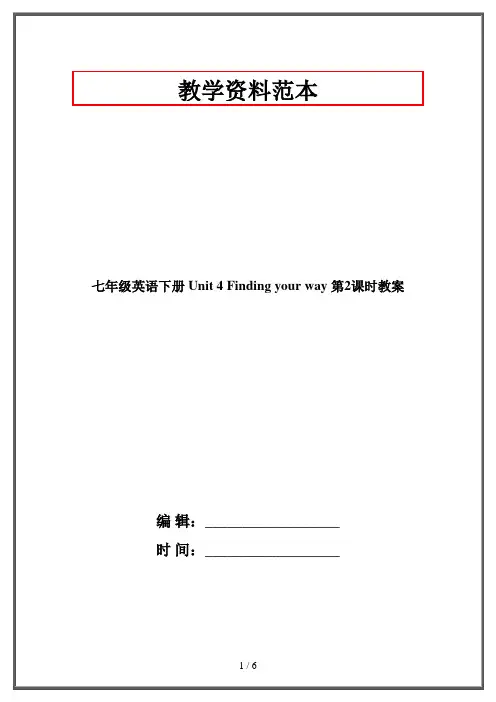
Unit 4 Finding your way 第2课时Reading(Ⅰ)【自学探究】(上课前预习一下课文,对你可有帮助啦,行动起来吧!)1. 学习本课的新词汇,理解他们的词义和词性,根据音标和规则试着读读,把不会读的记下来_____________________________________________________2. 跟着磁带朗读课文,多读几遍,要流利哦。
3. 预习课文,回答问题How many people are there in the story? Who are they?______________________________Do the children goto the park again? ____________________________________(通过预习你一定理解了许多新知识吧,快来检测一下,听课就会有的放矢啦!)A:词组翻译【教案】教学内容7B Unit 4 Reading Ⅰ课型新授课 阅读课教学目标 1 To introduce the style of the ghost story -To identify specific meaning by scanning the text.2 To predict meanings of specific words from the context3 To summarize key points of a story by Sequencing statements4. To identify key events and infer general meaning教学重难点1.规则动词+ed 后的读音2. 不规则动词过去式的变化教学方法情景教学法、归纳法教具准备课件教学步骤教师活动学生活动个性化补充Step 1 Lead inAsk a question: Which kind ofstory do you like best?love storyfunny storyexciting storyghost story通过问题引导学生思考故事的种类,为进入下一环节打下伏笔。
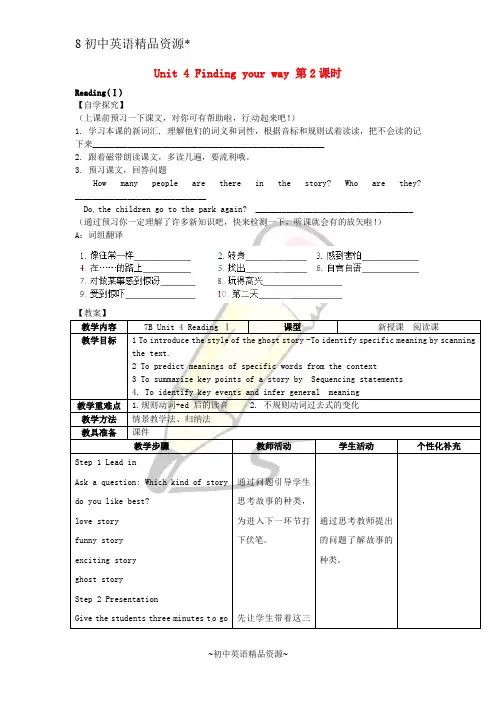
Unit 4 Finding your way 第2课时Reading(Ⅰ)【自学探究】(上课前预习一下课文,对你可有帮助啦,行动起来吧!)1. 学习本课的新词汇, 理解他们的词义和词性,根据音标和规则试着读读,把不会读的记下来_____________________________________________________2. 跟着磁带朗读课文,多读几遍,要流利哦。
3. 预习课文,回答问题How many people are there in the story? Who are they?______________________________Do the children go to the park again? ____________________________________(通过预习你一定理解了许多新知识吧,快来检测一下,听课就会有的放矢啦!)A:词组翻译教学内容7B Unit 4 Reading Ⅰ课型新授课阅读课教学目标 1 To introduce the style of the ghost story -To identify specific meaning by scanning the text.2 To predict meanings of specific words from the context3 To summarize key points of a story by Sequencing statements4. To identify key events and infer general meaning教学重难点 1.规则动词+ed 后的读音 2. 不规则动词过去式的变化教学方法情景教学法、归纳法教具准备课件教学步骤教师活动学生活动个性化补充Step 1 Lead inAsk a question: Which kind of story do you like best?love storyfunny storyexciting storyghost storyStep 2 PresentationGive the students three minutes t o go 通过问题引导学生思考故事的种类,为进入下一环节打下伏笔。
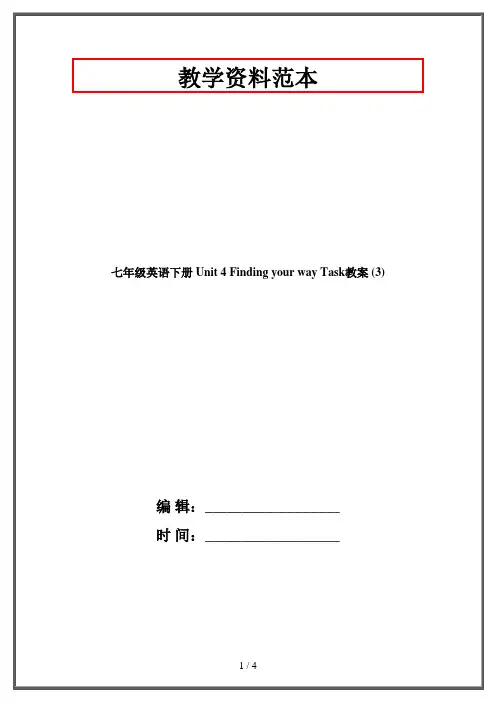
Unit 4 Finding your way Task教学目标1.表达对学校活动的喜爱程度。
2.说明喜欢或不喜欢某种活动的原因。
3.运用本单元所学知识写一篇文章,介绍自己对学校活动的喜欢程度教学要点教学重点运用本单元所学知识写一篇文章。
教学难点运用本单元所学知识写一篇文章。
教学法指导任务型教学法教具准备多媒体集体智慧个性设计教学后记Step1: Presentation1. T:What do you think of your school?Do you like it?Is your school life interesting?Is it colourful?I have some pictures and posters here.What activity isthis in the picture?Do you like it ?Why do you likeit?Why don’t you like it? Why do you dislike it?2.Teach the new word “dislike”e.g:She doesn’t like basketball.3.Make a happiness chart like PartA onPage52,according to the students’ answers.4.T:Today ,let’s talk about our school activities.Iwant to know your likes and dislikes.Are you ready?Doyo u get ready for class? Teach “ready”and “getready for”e.g We are ready for the party.Morning exercises help us get ready for theday.Step 2: Read PartA1.T:There are also many activities in Millie’sschool. Do you want to know her likes and dislikes?Lookat Milli e’s happiness chart in PartA . Plese tell me:What activities does Mille love?What activities does Mille like?What activities does Mille dislike?2.T:Plese read the rest of PartA.Can you tell me thereasons of her likes and dislikes?(1)Why does she like morning exercises?(2) Why does she love all her lessons?(3) Why does she dislike basketball?(4) Why does she love reading?(5) Why does she like drawing?(6) Why does she dislike homework?3. Teach the new word “world”e.g learn a lot about the worldall over the worldStep 3: Practice1.Guide the students to finish partB according to the information in PartA.2.Remind the students to pay attention to usefulexpressions in PartA.3.Ask one student to read the diary, the otherstudents check their answers.4.Read it together.Step 4:Students in role1.T:Let us do “students in role”.Ju st suppose thatyou are Mille.Why do you like morning exercises?Plese give some other reasons.2.Encourage the students to answer.Step 5: Writing1.T:Let’s read Mille’s diary .What does she writein the first paragraph?(It’s about her loves.)What does she write in the second paragraph?(About her likes.)What is Paragraph Three about?(About her disl ikes.)2.Work in groups of four.Discuss your likes anddislikes with your classmates and tell thereasons.Then make your own happiness chart.3. T:OK,try your best to write your own article .Youcan use some useful expressions on Page52.You canalso use Mille’s diary entry as a model.4.Ask some students to read their own article.Step6:Homework1.To remember the new words ,phrases and sentences.2. To read and recite the model article.3.To write an article板书设计。
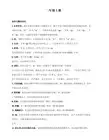
七年级下册英语Unit 4 Finding ur a教案(牛津版)七年级下册英语Unit4Findingura教案(牛津版)Unit4FindinguraistripandelettheunitTeahingAis:Intrduethelatinandtraffitpi2Talabutvisitandtraffide3DistinguishdiretinsStep1PresentatinShsepiturestlearnserdsabutdifferentdiretinstrippathnrthsutheastestnrth-estnrth-eastsuth-estsuth-east2Thenreadaludthenerdsfllvt跟随,效仿pathn小路,小径nrthn,ad≈adv 北,北方estn,ad≈adv 西,西方suthn,ad≈adv 南,南方eastn,ad≈adv 东,东方tripn旅行,旅游iletre=n千米,公里havet不得不,必须Step2PratisePratiseinpairsliethisttalabutheretheplaeisA:hereis…?(旅游)?B:It’snrth/suth/east/estf…2AsstudentstpletePartAnPage43Step3PresentatinPresentsepituresfrSstlearnhtgetthereThenasSstaesedi alguesStep4ListenandanserListentpartBandanserthefllingquestinherearethegingfrtheirlasstrip?hereisthez?Hillthegetthere?2Readafterthererder3Pratieinpairs4AtitutaetheirndialgueStepLearnthenversatinListentthetapeandas:)hereareHbandEddiestanding?2)hatdesHbasEddietdinthepiture?3)Dthehavetgupthehillagain?4)DesHbreallnthea?es:Thearenthetpfthehill2Heasshitgdnthehill3es,thed4N,hedesn’t2AtutthenversatinStep6Explanatin方位介词的用法小结benrth/suth/est/eastf在……北部/南部/西部/东部benrth-east/suth-estf在……东北部/西南部benrth-est/suth-eastf在……西北部/东南部AisinthefBAisnthe…fBAistthe…fB(A与B不接壤)2beafraidfdingsth/fsth害怕做某事beafraidthat…I’afraid…Step7ExerisesTranslatin别这么肯定。
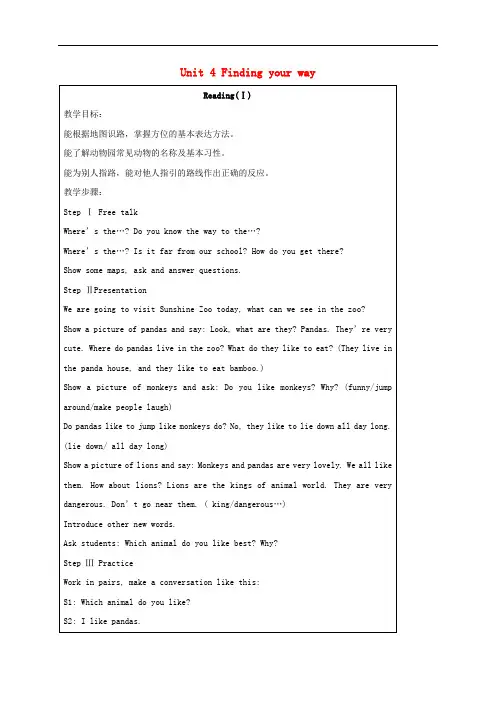
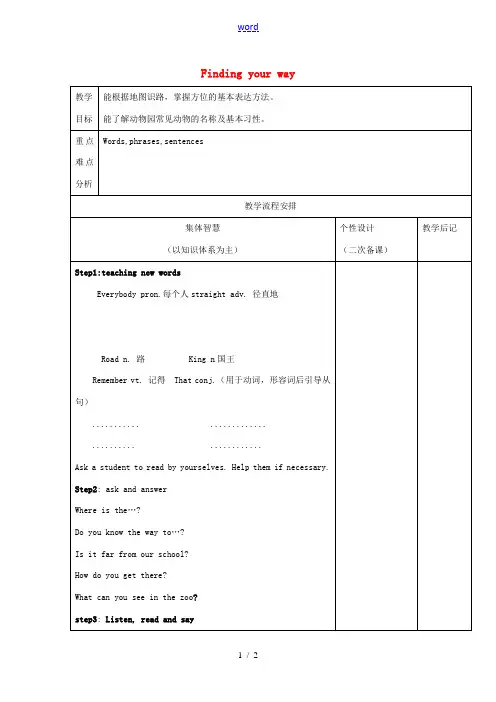
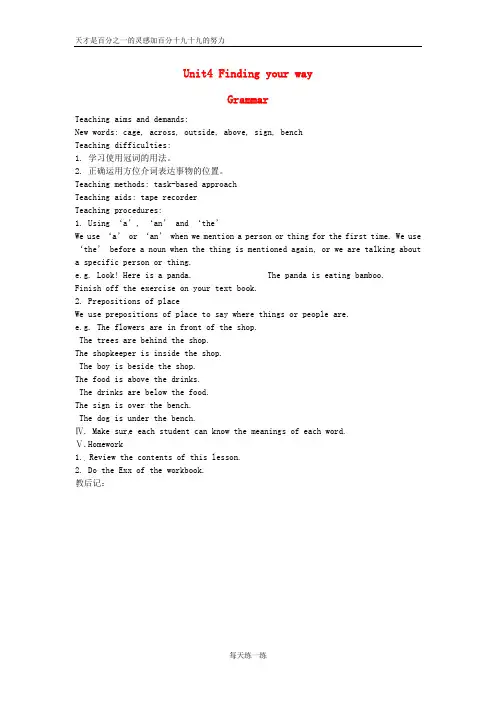
天才是百分之一的灵感加百分十九十九的努力Unit4 Finding your wayGrammarTeaching aims and demands:New words: cage, across, outside, above, sign, benchTeaching difficulties:1. 学习使用冠词的用法。
2. 正确运用方位介词表达事物的位置。
Teaching methods: task-based approachTeaching aids: tape recorderTeaching procedures:1. Using ‘a’, ‘an’ and ‘the’We use ‘a’ or ‘an’ when we mention a person or thing for the first time. We use ‘the’ before a noun when the thing is mentioned again, or we are talking about a specific person or thing.e.g. Look! Here is a panda. The panda is eating bamboo.Finish off the exercise on your text book.2. Prepositions of placeWe use prepositions of place to say where things or people are.e.g. The flowers are in front of the shop.The trees are behind the shop.The shopkeeper is inside the shop.The boy is beside the shop.The food is above the drinks.The drinks are below the food.The sign is over the bench.The dog is under the bench.Ⅳ. Make sur e each student can know the meanings of each word.Ⅴ.Homework1. Review the contents of this lesson.2. Do the Exx of the workbook.教后记:每天练一练。
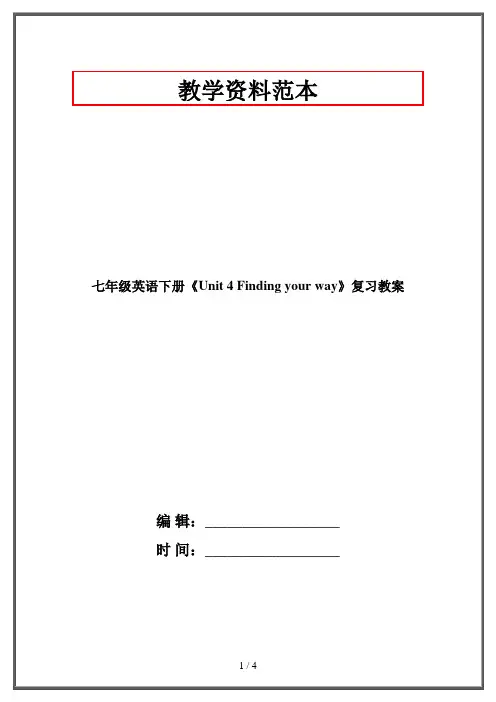
《Unit 4 Finding your way》一、教学目标:复习第四单元内容二、教学重点:复习第四单元内容三、教学难点:复习第四单元内容四、达标检测:一、单项选择( ) 1. —Hi, Daniel.Let’s play football after school. —But we don’t havefootball now.A. / ; aB. a ; aC. / ; /D. a ; /( ) 2. —Would you like to my home to have supper with us? —Sounds great! ( ) 3. Thank you very much for ______us so well.A.teachB. teachesC. teachingD.to teach( ) 4. _____ your brother a member of the basketball team? No, he ___ __ like playing basketball.A. Does, isB. Do, doesn’t C. Is, doesn’tD. Is, isn’t( ) 5. The boy is not friendly, so ________ students like him.A littleB a littleC fewD a few( ) 6 . They ______ watch Unusual Weekend. They think the actors act the wo rst.(差)A. oftenB. alwaysC. sometimesD. seldom( ) 7.--What’s the date today? ___________A. On 9 OctoberB. 1 OctoberC. On SundayD. At 10 o’clock( ) 8. --I have three apples, Do you want to have _____? --Yes,please. Thank you very much.A. itB. thisC. thatD. one( ) 9. The park is 500 metres ________ our school.A far away fromB far fromC away fromD far away ( ) 10. We often eat dinner at home on weekends, but ______ we eat out.A. sometimesB. seldomC. neverD. always( ) 11. Mum, can you at 8:00 tomorrow morning? _-- Of course, dear.A. wake up IB. wake I upC. wake up meD. wake me up( ) 12. ___ does your mother go for a walk?Every afternoon.A、How longB、How muchC、How oftenD、How many( )13. His father was born in Shanghai _______ the night________ Oc tober 1,1963.A. on; inB. at;ofC. at; onD. on; of( )14. --Do you have good friends at school? --Yes, they_________ me.A. are all nice forB. are all nice toC. all are nice toD. all are nice for二.根据句意,用所给单词的适当形式填空1.What time do you ________ get up in the morning? (通常)2.Andy is not strong. He ________ some exercise. (需要)3. Sandy enjoys _______ volleyball after class. (练习)4.I get best_________ from my friends. (祝愿)5.We do many after-school __________ in our school. (活动)6. Lily is a good girl. We all like _______ (she)7.Tens of peop le lost(失去) their _______ in the rainstorm(暴雨) inBeijing this summer. (life)8. The _________meeting will begin at 2:30 this afternoon. (parent) 9.My parents go to see a film with me ________ a month. (one)10. Shall we ______ with each other after lunch today? (chat)三.所给动词的形式填空。
Unit 4 Finding your way 第6课时Grammar B【自学探究】1. 写出be动词的过去式形式: am/is___________ are___________2. was 与__________________________连用, were与______________________连用。
请各举一个例子_________________________________________________________一、根据中文、英文解释或句意填入恰当的单词1.Girls are __________(afraid)when they see a mouse.2.You look so __________ (not strong).You need more exercise.3.Did you hear a __________ (soft noise)from the bushes?二、【教案】教学内容7B Unit 4 Grammar B 课型新授课 语法课教学目标掌握一般过去时的用法并能熟练使用教学重难点1.规则动词+ed 后的读音2. 不规则动词过去式的变化教学方法情景教学法、归纳法教具准备课件教学步骤教师活动学生活动个性化补充Step1. RevisionRevise the context we learnedlast lesson.Step2. Presentation1.Simple past tense of theverb ‘to be’We form the positive and negative sentences with the verb‘ to be ’ like this:带领学生回忆上节课的内容根据教师的提示,说出一般过去时的相关内容。
I/He/She/It was at home yesterday.I/He/She/It was not/wasn’t at home yesterday.2. Weask and answer questions with the verb ‘ to be ’ like this:Was I/he/she/it at home yesterday.Were you/we/they at home yesterday.Yes, I/he/she/it was .Yes, you/we/they were.No, I/he/she/it was not / wasn’t.No, you/we/they were not / weren’tYou/We/They were at home yesterday. You/We/They were not/weren’t at home yesterdayStep 3. PracticeDo exercises B1&B2.Step4. Check outTranslate sentences:1.20xx年以前你是医生吗?教师介绍一般过去时“tobe”的用法用书上的两个练习来检测学生的学习情况。
Unit 3 Finding your way一、教学内容:Unit 3 Finding your way二、教学目标:掌握Unit 3的词汇及词性的变化三、教学重难点:掌握课文中的重点短语的结构、用法Ⅰ. 基础词汇名词(n.): way n. 路;路线north n. 北;北方;北部north-west n. 西北;西北方south-west n. 西南;西南方 east n. 东;东方south n. 南;南方north-east n. 东北;东北方south-east n. 东南;东南方△character n. 人物police n. (常和the连用)警察;警方*uniform n. 制服robber n. 抢劫者,盗贼,强盗△van n. 厢式货车station n. 局;所;站;台route n. 路线,路径left n. 左边road n. 路;道路light n. 灯traffic n. 红绿灯,交通信号灯report n. 报告;报道note n. 笔记;短信,便条;注释laugh n. 笑set n. 一套;一副;一组crossroads n. 十字路口zebra crossing n. 斑马线*entrance n. 入口museum n. 博物馆corner n. 拐角;角落hotel n. 旅馆pool n. 水池;水塘△tunnel n. 隧道stair n. (常用复数stairs)楼梯railway n. 火车站step n. (一级)台阶side n. 侧,边bridge n. 桥gate n. 大门paper n. 纸,纸张*campfire n. 篝火turning n. 转弯处path n. 小路,小径field n. 地,田ground n. 地面market n. 市场△farewell n. 告别*barbecue n. 烧烤picnic n. 野餐fast food n. 快餐monitor n. 班长exit n. 出口bank n. 银行*footbridge n. 人行天桥动词(v.) follow vt. 跟随ring vi. (钟、铃等)响vt. 使响起铃声drive vi.&vt. 驾驶push vt. 推fail vi. 失败work vi. 起作用,奏效stop vi. & vt. 停止jump vi. 跳,蹦report vi. & vt. 报告;报道smile vi. 微笑mean vt. 意思是,意指laugh vi. 笑move vi. & vt. 移动cross vt. 穿过join vt. 加入,参加win vt. & vi. 赢得;赢,获胜bring vt. 带来;拿来形容词(adj.) afraid adj. 害怕,担心;恐怕*twin adj. 双胞胎的left adj. 左边的right adj. 右边的another adj. 另一个,别的surprised adj. 吃惊的,惊讶的open adj. 开着的,敞开的straight adj. 直的,笔直的correct adj. 正确的cloudy adj. 多云的介词(prep.) down prep. 沿……而下along prep. 沿着across prep. 穿过through prep. 穿过,通过round prep. 围绕,环绕towards prep. 向,朝代词(pron.) everybody pron. 每人,人人副词(adv.) down adv. 向下quickly adv. 迅速地,飞快地again adv. 再,又left adv. 向左 right adv. 向右suddenly adv. 突然happily adv. 愉快地;幸福地forward adv. 向前straight adv. 径直right adv. 恰恰,正好【典型例题】单词拼写1. You can take different ______________( 路线) to the library .2. Help! There are some ______________( 强盗) in the building .3. The man drives his car to the town __________(很快地)4. The boy tries to open the door but ____________( 失败了) .5. The zoo is __________(东南) of the city .6. He runs out of the classroom _____________(突然地) .7. The man in yellow _________( 制服) is Mr Li.8. These __________(小刀) are made of wood .9. There are two _________ (旅馆)near our school.10. Our ________( 班长) is Li Ming .11. Where is the (出口) to the new supermarket?12. Excuse me. How can I get to the food (市场)?13. Walk down the (台阶), and you can find the park.14. My computer doesn’t(工作). Can I use yours, Millie?15. I can see three (桥) in the picture on the wall.16. Sunshine Park is (正好) opposite the cinema.17. (人人) will be very happy at Tom's birthday party.18. Please (带来) me a piece of paper this afternoon.19. All of you should go down the (楼梯) carefullyⅡ. 重点词组7B Unit 3 词组1. follow sb 跟随某人follow me 跟着我2. Let’s go down / up here 让我们从这儿下/上3. Don’t be afraid. 别害怕。
七年级下册英语Unit 4 Finding your way教案(牛津版)七年级下册英语Unit 4 Finding your way教案(牛津版)Unit 4 Finding your waand WeluTeachingAims:Introduce the location and tra2. Talk about visit and traffic modDistinguish dPresentawures to leawords about ddauth east w-w-east south-west south-east2. Then read aloud the new wordllow vt. 跟随,效仿path n. 小路,小径adj. adv. 北,北方wadj. adv. 西,西方south n., adj. adv. 南,南方east n., adj. adv. 东,东方旅行,旅游kil千米,公里have to 不得不,必须2. PraPraairs lalk about wlaA: W…? (旅游)?B: It’/ south/east/west of …2. Ask studlete Part A on PagPresentaPulearn how to gThen aadialoguListen and answLart B and answllowing quWhere agoinglass trip?W?How will they g?2. Read adPraaAct it ouawn dialoguLeaversaLape and ask:1) Where are Hobo and Eddie standing?2) What does Hobo ask Eddie to dure?3) Dave to go ull again?4) Does Hobo really know the way?:They all.2. He ago dowlldNo, he doesn’t.2. Act ouversaxplana方位介词的用法小结be north/ south/ west/ea在……北部/南部/西部/东部be north-east/ south-w在……东北部/西南部be north-west/ south-ea在…… 西北部/东南部 AB (A在B内部……方位)A…of B (A与B接壤)A…of B (A与B不接壤)2. be afraid of doing sth./害怕做某事be afraid that…I’m afraid…xTransla别这么肯定。
教学目标能了解邀请函的写作格式。
能在写邀请函的语境中组织信息并指明路线。
重点难点分析同上教学流程安排集体智慧(以知识体系为主)个性设计(二次备课)教学后记Step 1.teach new words .There are plenty of bank s in China.They prepare a lot of food and drink for the party.Help them if necessary.Step 2.listen and followRe ad aloud. play the tape for the Ss.Step3 finish A2 on page 49.check the answers together.Step 4. Pair work1. Where will you have the party?2. What food will you have?3. Who will you invite to your party?4. How will you invite your friends to your party? Step5. Listen and answer1 When and whereis Suzy going to have her birthday party?She’s going to have the party at home thisweekend.2. What time will the party start?It’ll start at 2 p.m. on Sunday, 21 April.Step6 fill in the blanks。
( 英 语 教 案 ) 学 校:_________________________
年 级:_________________________
教 师:_________________________
教案设计 / 精品文档 / 文字可改
七年级英语:Finding your way教案(实用文本)
Learning English is conducive to making friends, chatting or working together with foreigners, and learning English is very useful for traveling abroad. 教学文本 | DOCUMENT TEMPLATE 七年级英语教案
第 2 页 七年级英语:Finding your way教案(实用文本)
unit 3 finding your way period 4 课前预习 一、写出下列单词的词义、词性和音标 crossroads_____ _____ ____ sraight ____ ____ ____ traffic ____ _____ ____ zebra ____ _____ ____ entrance _____ _____ ____ correct _____ _____ ____ 二、将下列词组译成英语 1. 斑马线_____ 2. 向右转_______ 3. 来到十字路口_____ 4. 路的拐角处 ____ 5. 穿过马路 _____ 6. 在你的右边 _____
教材简介:学习英语有利于和外国人交朋友,聊天或者一起工作,本教学设计资料适用于初中七年级英语科目,学习本教材的学生可以提高自身技能,本文档是按照教材进行修订编写,可以放心的进行教材使用。 教学文本 | DOCUMENT TEMPLATE 七年级英语教案
第 3 页 learning procedures: activity 1 revision step 1. t: please look at the map on page 46 c2. can you retell the story in your own words? (turn right, turn left, traffic lights) step 2. t: show them signs of ‘turn left’, ‘turn right’ and ‘traffic lights’. which one is ‘turn right’? which one is ‘turn left’? which picture means ‘traffic lights’? s:… activity 2 presenting step 1. t: look at these three signs. (zebra crossing, straight on, crossroads) step 2. t: now, can you come to the blackboard and write down the correct words on the right places? ( give them some road signs) 教学文本 | DOCUMENT TEMPLATE 七年级英语教案
第 4 页 s: … t: when you cross the roads, you must know about these signs. activity 3 doing activities sep 1. ask one student to come the front and show others the road signs. divide the other into 2 groups. one group ask: what can you do when you see this sign? the other group answer: i can (must) turn left/turn right/go straight on/be careful/cross the road. step 2. ask the students do the exercises on page 47 part a. activity 4 presenting step 1. draw the map on page 47 part b, read the article to the students and invite some of them to choose which one is right. step 2. t: now please open your book and check the answers together. 教学文本 | DOCUMENT TEMPLATE 七年级英语教案
第 5 页 step 3. key structures: 1) turn right and you will find it on the left. 2) walk along the road and turn left. it’s on the left. 3) come to the crossroads and walk straight on. you’ll see it on the right. 4) when you come to the corner of the road. turn right and you’ll find a hotel. cross the road and the museum is opposite the hotel. activity 5 supplementary exercises 1) is there an underground near here? 2) a: how can i get to the zoo? b: go straight on and turn left at the second crossing. 3) a: where’s the library? b: it’s down bridge road on the left. 4) a: could you tell me the way to the museum? b: go down this road till the corner, turn right and you’教学文本 | DOCUMENT TEMPLATE 七年级英语教案
第 6 页 ll see it. 5) a: please tell me the way to the sunnyside park? b: walk along the street and take the first turning on the right. . they got out of their car at once. 他们立刻从汽车里出来。 out of… 介词短语,“从…出来;从…离开;出于,由于;缺乏;没有”。例如: jim’s mother has been out of danger. 吉姆的母亲已脱离危险。 fish can’t live out of water.鱼离了水就不能活。 we are out of tea.我们的茶叶用完了。 课后练习 一 英汉互译 1. 穿过马路,警察局就在你的左边。 2. 你能告诉我去警察局的路吗? 教学文本 | DOCUMENT TEMPLATE 七年级英语教案
第 7 页 3.他一直往前走,然后左拐进了一家宾馆。 4.你来到交通灯处,右拐,就能看见动物园了。 5.当你来到路的拐角处,你就看见入口处在左边。 二 句型转换. 1. susan wants to close the window, but it doesn’t work. (改为同义句) susan wants to close the window _____ _____. (but fails) 2. take the second turning on the right. (改为同义句) ____ ____ at the _____ turning. ( turn right, second) 3. let’s go along the lake. (先改为反意疑问句,再改为同义句) ____ ____ go along the lake? ( why not) let’s go along the lake, ____ ____? (shall we) 4. to my surprise, i meet a friend of mine here. (改为同义句) i _____ _____ ____ _____ a friend of mine here. (am 教学文本 | DOCUMENT TEMPLATE 七年级英语教案
第 8 页 surprised to meet) 5. there is a big building near my home. there is a supermarket near my home.(将两句并为一句) there is ____ ____ ____ ____ ____ ____ near my home. 6. my school is between a park and a shop.(对划线部分提问) ____ ____ ____ ____? 7. on, a, through, the, take, walk, zhongshan, park, road (连词成句) ________ 8. there is a big supermarket next to this road.(改为一般疑问句并作肯定回答) _____ ____ a big supermarket next to this hotel? _____ ____ ____. 9. how, me, you, to, tell, let, there, get(连词成句) ________